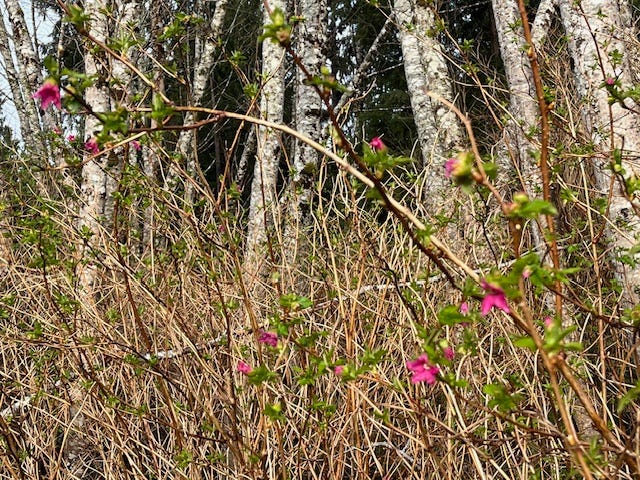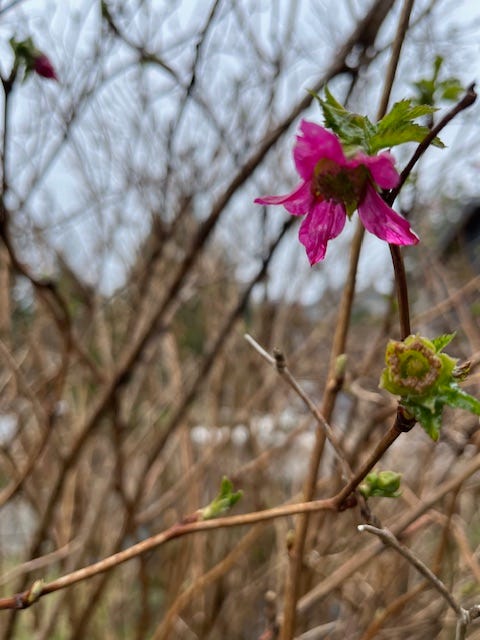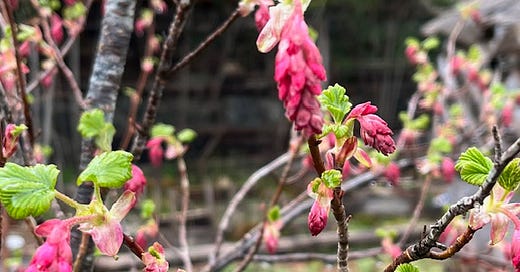Traditional Japanese calendars divide the year into 72 seasons. (Actually, 24 major divisions each split again into three.) Here on the west coast of Vancouver Island, the cynic in me would divide this time of year into two seasons: raining and brief-respite-in-the-rain-when-I-run-out-to-do-a-garden-task-before-it-starts-raining-again. I jest, of course. Sort of. After more than 30 years of living here, I’ve developed weather amnesia as a coping mechanism. Give me a sunny day and I forget all the rain that’s come before. (As I should; we live in a rainforest, after all.)
In the lunar calendar of the Nuu-chah-nulth people1, in whose territory I live2, late winter, early spring is c̓umaasumł, earth cleansing/earth washing moon, which is a lovely way to think of rain and a good reminder that we’re in charge of changing our attitude. This time of year, just past the spring equinox, is ʔaayaqumł, the spawning or herring moon, when herring return to coastal waters and spawn, turning the water a milky turquoise.
It’s grey and drippy and muddy in my yard and the forest, but I’m heartened at this time of year by the two flashes of vibrant pink: blooms of the red-flowering currant and salmonberry.
Red-flowering currant (aka the plant that paid for David Douglas’s botanizing)
Isn’t it a beauty? The branches are loaded and the drooping clusters — racemes — of deep pink flowers are just starting to open. Ribes sanguineum = acid- or sour-tasting (from ribas, Arabic for rhubarb/sour sap3) and bloody or blood-red (from sanguis, Latin for blood). “Blood red” seems off to me as a descriptor, but I’d be down with having shocking pink blood! The blue-black berries are apparently edible, but insipid, but I’ll watch for them later in the year and see if I can sneak a taste before the birds do. (Here is one very devoted forager’s account of making fruit leather from these berries.)
Red-flowering currant is native to western coastal North America and I’ve never really thought of it as a nursery plant — other than in nurseries specializing in native plants, of course — so I was surprised to read that this plant was a hit with UK gardeners almost 200 years ago. Apparently Scottish botanist David Douglas came across the plant near Fort Vancouver in 1825.4 He shipped some seeds back to the Royal Horticultural Society back in the UK and the plants they produced quickly became a favourite for home gardeners and the money raised — about 400 pounds — helped pay for one of his expeditions. I can see why they are popular with home gardeners. Their blooms give welcome beauty at this time of year, not only for me, but also for hummingbirds and early emerging bees. Apparently the leaves are also an important larval food source for moths and butterflies.
Salmonberry (spectacular, dahlin’!)


I’ve been taking part in a phenology study for years now in which we track the timing of salmonberry blooms. This native shrub in the raspberry family sprouts all over our yard. I have to keep it under control in places, but I leave one bush at the edge of our driveway, which is my test plant for the bloom timing study. The flirty, skirt-like blooms of Rubus spectabilis (spectacular! showy!) have been pops of pink on the landscape for a few weeks now. I noticed the first bloom around March 10.
Like the red-flowering currant, this plant brings in the hummingbirds — I’m yet to see one though — and they also indicate the eventual return of Swainson’s thrushes, aka the “salmonberry bird,” which “sings up the salmonberry.” What an image — a bird conjuring a berry into being with its song.
The berries resemble a little cluster of salmon roe and range from golden-yellow to deep orange-red. They’re very juicy, and I think a little weak tasting, but, still, they’re the first wild berry to ripen around here so it’s hard to resist a nibble. I leave most of them for the birds. (The fresh green shoots, gently peeled, are delicious though.)
Salmonberry plants are an important plant for Indigenous peoples of the west coast, and I encourage you to read this essay by writer ‘Cúagilákv (Jess Housty) as she explores her relationship with this plant.
For most Haíɫzaqv (Heiltsuk) children, the relationship between salmon and salmonberries is the first indicator—a sign from the natural world—we are taught. A good crop of salmonberries, we are told, corresponds to a good salmon run and luck in the harvest, and a poor crop is an early signal that we should turn to other species for our winter stores. We learn about this nourishing interrelationship early in our lives and it goes on to pattern our worldview.
Poet Rena Priest also writes a beautiful ode to a salmonberry in her poem Tour of a Salmonberry.
A salmonberry is a
luminous spiral,
a golden basket,
woven of sunshine,
water, and birdsong.
So that’s all for now. If you enjoy this, and think someone else might too, please share. Here’s a handy dandy button:
What signs of spring are you noticing at the moment? Pop me a comment.
For some reason the link won’t hold, but here is the URL: https://nuuchahnulthlivingarchive.com/word-list/nuučaan̓uł-lunar-calendar
More specifically, my home is in traditional territory of the Tla-o-qui-aht First Nations. Nuu-chah-nulth is a larger grouping of First Nations on the west coast of Vancouver Island.
Obviously I’m no professional etymologist, but there is a lot of sort of similar/a bit confusing definitions for Ribes, so this is my close approximation. My Dictionary of Word Roots and Combining Forms — my “bible” that I have had since my biology undergrad days — says “ribes (Ar.) A plant with sour sap.” And my door stop of a Webster’s dictionary (it weighs 4.1 kg [9 lb.s 13.8 oz]) says Ribes is from Ribas, “a name given by the Arabian physicians of the eleventh and twelfth centuries to a species of rhubarb, and erroneously supposed to apply to the currant plant.” If you know/care more, weigh in!





Love this….“— a bird conjuring a berry into being with its song.”
Hi Adrienne, Beautiful story and great photos.I love that there is a bird that calls up this beautiful bloom. I was at Agriculture day March 22 2025.I had a chance to talk with Matthew Roy and Linda Best and forwarded your name to each of them. Cheers Susan